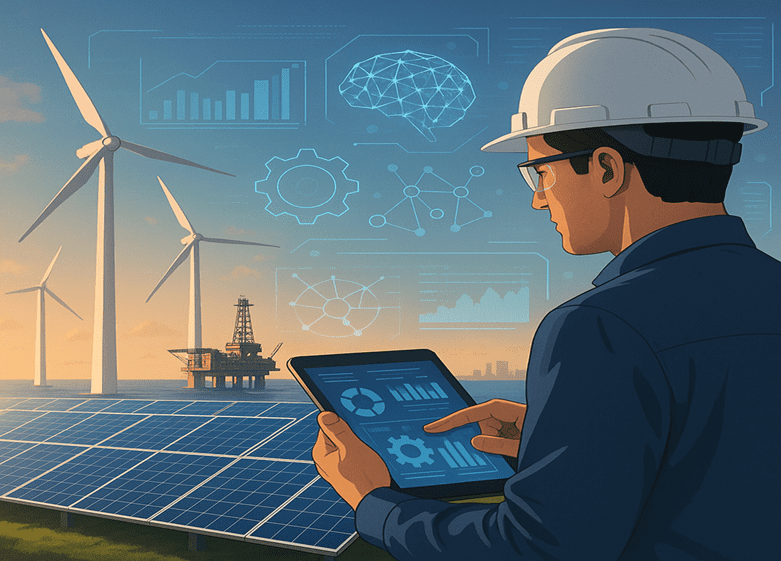The global energy sector is undergoing one of the most revolutionary changes in history. Shaped by environmental pressure, risk of demand, and global momentum towards net-zero, energy companies are remaking the way they operate—through technology. In 2025, innovation is no longer a value add; it’s a way to survive.
From wind farms spread across deserts to oil rigs in the middle of the ocean, these are the five tech trends transforming the way energy is generated, used, and managed.
- AI and Machine Learning: From Data Chaos to Predictive Brilliance
Energy firms have been collecting gobs of data–seismic scans, satellite imagery, grid demand–for decades. Now, and only now, with AI and machine learning, can they finally start to make sense of it all.
Shell and others are using AI in upstream oil prospecting to process subsurface information faster, improve the accuracy of drilling, and reduce exploration costs. Predictive maintenance models using ML are also identifying equipment fatigue before it causes breakdowns, saving millions in unplanned downtime.
In renewables, AI is being utilized by wind farm operators to better forecast wind patterns, optimizing turbine placement and energy production. Such analysis is worth its weight in gold for grid demand balancing against renewables variability.
- Robotics and Automation: The New Frontline Workforce
Dirty, dangerous, and inaccessible—that’s how much of the energy industry’s field work has been described. Now, equipment is moving into these areas, performing duties that were too dangerous, time-consuming, or too dirty for men.
Consider TotalEnergies’ deployment of autonomous inspection robots on North Sea offshore platforms. The wheeled or legged robots crawl through corridors, identify gas leaks, and transmit live images to engineers back onshore—eliminating the need for people to be in a hostile environment.
At solar farms, thermal-sensing drones now survey thousands of panels in a few minutes, a fraction of the time it would take human crews. It’s a matter of automation, not just safety; it’s a big leap forward in operational speed and accuracy.
- IoT and Smart Sensors: Real-Time Awareness Across the Grid
The Internet of Things (IoT) is among the most transformative technologies of modern energy operations. Smart sensors now monitor everything from refinery emissions and pipeline pressure to battery storage capacity in real time.
Such as Chevron’s deployment of over 30,000 sensors across its Permian Basin operations. Sensors feed into an analytics dashboard to watch flow rates, temperature, and vibration—allowing remote crews to react the instant something fails.
In renewables, smart inverters and energy management systems are allowing two-way communication between grid operators and distributed energy resources (e.g., rooftop solar panels) for stability in a more decentralized grid.
- Blockchain: Transforming Energy Transactions
The influence of blockchain goes far beyond cryptocurrency within the energy industry. It’s facilitating new business models of decentralization, transparency, and trust.
Blockchain-based peer-to-peer (P2P) energy trading platforms allow homeowners or businesses that own solar panels to sell surplus electricity to neighbors directly. In countries such as Australia, organizations such as Power Ledger are already piloting the waters with remarkable success.
Blockchain disrupts the old paperwork, go-betweens, and holdups that have haunted the sector to eternity in oil trading. BP, Shell, and Equinor are among the participants in VAKT, a blockchain network that automates post-trade operations, significantly reducing fraud and mistakes.
- Mobile & Digital Tools: Equipping the Workforce on the Ground
Field crews today are more than hard hats and clipboards—they carry tablets, AR glasses, and smartphone apps that provide instant access to cloud-based networks.
Companies are also utilizing QR codes increasingly to give technicians real-time access to technical manuals, repair history, or safety procedures. For instance, a solar panel installation worker can scan a sticker generated with a QR code generator to see the performance record of a panel, reducing the need for manual checking of documents and the resultant errors.
In refineries, mobile inspection software makes compliance easy and reduces paperwork. Apps will guide crews through electronic checklists, synchronize data with central databases, and even automatically alert alarms over anomalies.
Augmented reality (AR) is also being used to assist new technicians. With AR headsets, a new engineer can be provided with real-time visual guidance imposed over physical equipment, reducing the learning curve and improving accuracy.
The Road Ahead: Tech + Energy = Resilience
As energy infrastructure becomes increasingly advanced—and the world turns up its efforts toward sustainability—technology will be the main driver of agility, safety, and profitability. The 2025 visionaries aren’t just creating electricity; they’re engineering smart, responsive, and sustainable systems.
From a robotic dog sweeping offshore platforms to a blockchain-secured smart grid powering city blocks, innovation is no longer an idea of the future but a reality now.
Ready to boost competitiveness in your business in an industry that’s evolving at breakneck rates? It starts by embracing today these technologies—because the future of energy is now.





